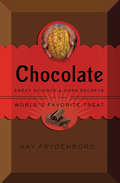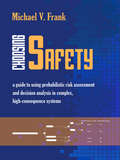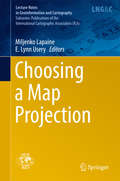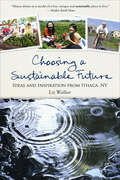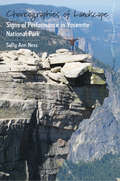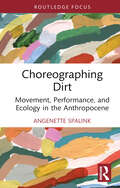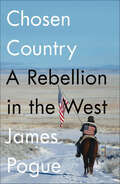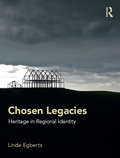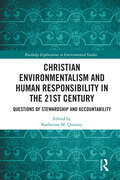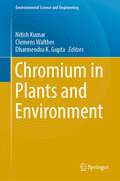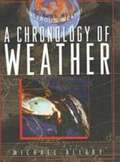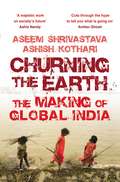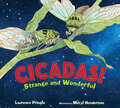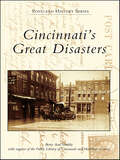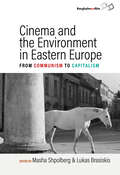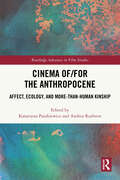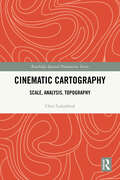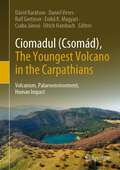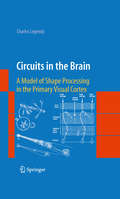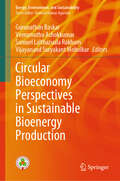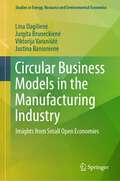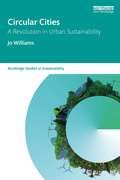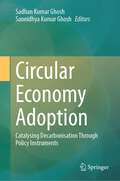- Table View
- List View
Chocolate: Sweet Science & Dark Secrets of the World's Favorite Treat
by Kay FrydenborgChocolate hits all the right sweet--and bitter--notes: cutting-edge genetic science whisked in with a strong social conscience, history, and culture yield one thought-provoking look into one of the world's most popular foods. Readers who savored Chew on This and Food, Inc. and lovers of chocolate will relish this fascinating read.
Chomp: A Shark Romp
by Michael PaulDive in to the depths of the ocean to discover different species of sharks in this nonfiction picture book with simple text and illustrations.Many different kinds of sharks are swimming below the ocean's surface.Some sharks are gentle, and some sharks are fierce. Some are awake in the day, and some are awake at night. Some eat almost anything, and some are very picky.You may not be able to visit their watery world, but you can always visit them up close at the aquarium.Simple text and bold illustrations take young explorers on a deep dive through the ocean full of sharks.Don't Miss More from Michael Paul in Roar: A Dinosaur Tour!
Choosing Green: The Homebuyer's Guide to Good Green Homes
by Jerry YudelsonDrawing from the expertise of dozens of homebuilders, government officials, and green home experts, Choosing Green deftly takes the reader through these considerations with easy-to-use tables, charts, maps, score sheets, and checklists. The book includes a glossary of green building terms, an extensive resource section, and a list of homebuilders, green rating programs, and financial incentives. This comprehensive book provides home buyers with every thing they will need to make a successful search for their own green home.
Choosing Safety: A Guide to Using Probabilistic Risk Assessment and Decision Analysis in Complex, High-Consequence Systems
by Michael V. FrankThe technological age has seen a range of catastrophic and preventable failures, often as a result of decisions that did not appropriately consider safety as a factor in design and engineering. Through more than a dozen practical examples from the author‘s experience in nuclear power, aerospace, and other potentially hazardous facilities, Choosing Safety is the first book to bring together probabilistic risk assessment and decision analysis using real case studies. For managers, project leaders, engineers, scientists, and interested students, Michael V. Frank focuses on methods for making logical decisions about complex engineered systems and products in which safety is a key factor in design - and where failure can cause great harm, injury, or death.
Choosing a Map Projection (Lecture Notes in Geoinformation and Cartography)
by Miljenko Lapaine E. Lynn UseryThis book offers a much-needed critical approach to the intelligent use of the wide variety of map projections that are rapidly and inexpensively available today. It also discusses the distortions that are immanent in any map projection. A well-chosen map projection is one in which extreme distortions are smaller than those in any other projection used to map the same area and in which the map properties match its purpose. Written by leading experts in the field, including W. Tobler, F. C. Kessler, S. E. Battersby, M. P. Finn, K. C. Clarke, V. S. Tikunov, H. Hargitai, B. Jenny and N. Frančula. This book is designed for use by laymen. The book editors are M. Lapaine and E. L. Usery, Chair and Vice-Chair, respectively, of the ICA Commission on Map Projections for the period 2011-2015.
Choosing a Sustainable Future: Ideas and Inspiration from Ithaca, NY
by Liz WalkerA small city's big vision that can help transform your own community. We all want a sustainable future, but what does it look like, and how do we get there? In Ithaca, NY a new culture is blossoming-one that values cooperation, local production, environmental stewardship, social justice andcreativity. Ithaca is showing the way to meet the challenges of the day with a wide variety of practical, real-world solutions.Filled with inspiring examples, Choosing a Sustainable Future provides readers with a remarkable sense of possibility. Explore Ithaca's:bustling, vibrant farmers markets, overflowing with fresh, local produceaward-winning community credit union that triples the savings of low-income peopleflagship college sustainability programspioneering alternative transportation programs, such as Ithaca Carshareinnovative efforts by coalitions of local business, university, government and activists to create transformation in areas as diverse as green building, city planning, health and wellness, and honoring cultural diversity.Taken together, these examples of citizen engagement are a taste of what life could be like in a sustainable city of the future. In a time of overwhelming economic, social and environmental crises, Choosing aSustainable Future provides a quiet, authoritative voice of hope.
Choreographies of Landscape: Signs of Performance in Yosemite National Park
by Sally Ann NessAs an international ecotourism destination, Yosemite National Park welcomes millions of climbers, sightseers, and other visitors from around the world annually, all of whom are afforded dramatic experiences of the natural world. This original and cross-disciplinary book offers an ethnographic and performative study of Yosemite visitors in order to understand human connection with and within natural landscapes. By grounding a novel "eco-semiotic" analysis in the lived reality of parkgoers, it forges surprising connections, assembling a collective account that will be of interest to disciplines ranging from performance studies to cultural geography.
Choreographing Dirt: Movement, Performance, and Ecology in the Anthropocene (Routledge Studies in Theatre, Ecology, and Performance)
by Angenette SpalinkThis book is an innovative study that places performance and dance studies in conversation with ecology by exploring the significance of dirt in performance. Focusing on a range of 20th- and 21st-century performances that include modern dance, dance-theatre, Butoh, and everyday life, this book demonstrates how the choreography of dirt makes biological, geographical, and cultural meaning, what the author terms "biogeocultography". Whether it’s the Foundling Father digging into the earth’s strata in Suzan-Lori Park’s The America Play (1994), peat hurling through the air in Pina Bausch’s The Rite of Spring (1975), dancers frantically shovelling out fistfuls of dirt in Eveoke Dance Theatre’s Las Mariposas (2010), or Butoh performers dancing with fungi in Iván-Daniel Espinosa’s Messengers Divinos (2018), each example shows how the incorporation of dirt can reveal micro-level interactions between species – like the interplay between microscopic skin bacteria and soil protozoa – and macro-level interactions – like the transformation of peat to a greenhouse gas. By demonstrating the stakes of moving dirt, this book posits that performance can operate as a space to grapple with the multifaceted ecological dilemmas of the Anthropocene. This book will be of broad interest to both practitioners and researchers in theatre, performance studies, dance, ecocriticism, and the environmental humanities.
Chosen Country: A Rebellion in the West
by James Pogue"Whoever you are, whatever side you’re on, if you care about the American west and what’s happening to it, read this book."—Caroline Fraser, Pulitzer Prize-winning author of Prairie FiresAn extraordinary inside look at America’s militia movement that shows a country at the crossroads of class, culture, and insurrection.In a remote corner of Oregon, James Pogue found himself at the heart of a rebellion. Granted unmatched access by Ammon Bundy to the armed occupation of the Malheur National Wildlife Refuge, Pogue met ranchers and militiamen ready to die fighting the federal government.He witnessed the fallout of communities riven by politics and the danger (and allure) of uncompromising religious belief. The occupation ended in the shooting death of one rancher, the imprisonment of dozens more, and a firestorm over the role of government that engulfed national headlines. In a raw and restless narrative that roams the same wild terrain as his literary forebears Edward Abbey and Hunter S. Thompson, Pogue's Chosen Country examines the underpinnings of this rural uprising and struggles to reconcile diverging ideas of freedom, tracing a cultural fault line that spans the nation.
Chosen Legacies: Heritage in Regional Identity
by Linde EgbertsThe urge for regional identity has not declined in the process of globalization. Rather, heritage is used to develop regional distinctiveness and to charge identities with a past. Particularly helpful for this aim are creation stories, Golden Ages or recent, shared traumas. Some themes such as the Roman era or the Second World War appear easier to appropriate than, for example, prehistory. This book assesses the role of heritage in the construction of regional identities in Western Europe. It contains case studies on early medieval heritage in Alsace and Euregio-Meuse Rhine, industrial heritage in the German Ruhr area and competing memories in the Arnhem-Nijmegen region in the Netherlands. It presents new insights into the process of heritage production on a regional level in relationship to processes of identity construction. The theoretical analysis of "heritage" and "regional identity" is innovative as these concepts were hardly analysed in relation to each other before. This book also offers insights into policy, tourism, spatial development and regional development to policymakers, politicians, designers and professionals in the heritage and tourism industries.
Christian Environmentalism and Human Responsibility in the 21st Century: Questions of Stewardship and Accountability (Routledge Explorations in Environmental Studies)
by Katherine M. QuinseyChristian Environmentalism and Human Responsibility in the 21st Century comprises original scholarly essays and creative works exploring the implications of Christian environmentalism through literary and cultural criticism and creative reflection. The volume draws on a flourishing recent body of Christian ecocriticism and environmental activity, incorporating both practical ethics and environmental spirituality, but with particular emphasis on the notion of human responsibility. It discusses responsibility in its dual sense, as both the recognized cause of environmental destruction and the ethical imperative of accountability to the nonhuman environment. The book crosses boundaries between traditional scholarly and creative reflection through a global range of topics: African oral tradition, Ohio artists off the grid, immigrant self-metaphors of land and sea, iconic writers from Milton to O’Connor to Atwood, and Indigenous Canadian models for listening to the nonhuman Mother of us all. In its incorporation of academic and creative pieces from scholars and creative artists across North America, this volume shows how environmental work of its nature and necessity crosses traditional academic and community boundaries. In both form and orientation, this collection speaks to the most urgent intellectual, physical, social, and spiritual needs of the present day. This book will appeal to scholars, researchers, and upper-level students interested in the relationship between religion and environment, ethics, animal welfare, poetry, memoir, and post-secularism.
Chromium in Plants and Environment (Environmental Science and Engineering)
by Nitish Kumar Dharmendra K. Gupta Clemens WaltherThis edited book brings together a diverse group of environmental science, sustainability, and health researchers to address the challenges posed by global mass poisoning caused by chromium contamination of soil and plants. In recent years, contamination of the environment by chromium has become a major concern. Chromium is a non-degradable, harmful, and toxic pollutant which negatively affects the environment. It is unique among the heavy metals found in industrial wastewater and sewage and sludge, as it may exist as a trivalent cation and as anion in the hexavalent state in the pH range of agricultural soils. It is used on a large scale in many different industries, including metallurgy, electroplating, production of paints and pigments, tanning, wood preservation, chemical production, and pulp and paper production. These industries are contributing larger amount of chromium, which can ultimately have significant adverse effects on biological and ecological activities of ecosystem. Chromium enters the food chain through consumption of plant material. A high concentration of chromium has been found to be harmful to vegetation. As the chromium concentration in plants increases, it adversely affects several biological parameters and eventually renders the soil barren.The book sheds light on this global environmental issue and proposes solutions to contamination through multi-disciplinary approaches and case studies from different parts of the world.This book is a valuable resource to students, academicians, researchers, and environmental professionals who are doing field work on chromium contamination throughout the world.
Chronology of Weather (Dangerous Weather)
by Michael AllabyFrom the Book Jacket: A Chronology of Weather presents an overview of the dangerous weather described in preceding volumes in the series. It includes a time line of catastrophic weather events from c. 3,200 B.C. to 1997, as well as a chronology of meteorological discovery-comprising the lives and inventions of great weather scientists-from c. 340 B.c. to 1995. A Chronology of Weather also contains weather experiments that students can perform at home using ordinary household supplies, a glossary of meteorological terms, charts for wind measurement and cloud classification, and further readings suggested by the author. The Dangerous Weather series imparts fundamental weather science to readers through author Michael Allaby's vivid descriptions of extreme weather systems. The series focuses on the five most dangerous kinds of weather activity; diagrams related meteorological, climatological, and environmental basics in clear, compelling language; chronicles the history of each form of dangerous weather; and offers safety precautions for extreme weather conditions. Fully illustrated and indexed, the Dangerous Weather series is an invaluable tool for student research. Other volumes include: hurricanes tornadoes droughts blizzards floods Other books in this series are also available from Bookshare.
Churning the Earth: The Making of Global India
by Aseem ShrivastavaThe world stands so dazzled by India's meteoric economic rise that we hesitate to acknowledge its consequences to the people and the environment. In Churning the Earth, Aseem Shrivastava and Ashish Kothari engage in a timely enquiry of this impressive growth story. They present incontrovertible evidence on how the nature of this recent growth has been predatory and question its sustainability. Unfettered development has damaged the ecological basis that makes life possible for hundreds of millions resulting in conflicts over water, land, and natural resources, and increasing the chasm between the rich and the poor, threatening the future of India as a civilization.
Cicadas!: Strange and Wonderful (Strange and Wonderful)
by Laurence Pringle"Definitely the best cicada book for kids. Adults will appreciate it as well, as it is well written, factually accurate, and beautifully illustrated." —Cicadamania.com Discover why cicadas are all the buzz in the most complete, comprehensive book for kids about these noisy but harmless insects.Every year, annual cicadas emerge and pierce the air with their buzzing calls. Also every year, at least one brood of 13 or 17 year cicadas emerges in some part of the eastern or central United States. In Spring 2021, a group of 17 year periodical cicadas called Brood X will make their appearance in the Mid-Atlantic region of the United States. Author Laurence Pringle and illustrator Meryl Henderson have created the story of this fascinating and often misunderstood insect, one that deserves to be protected.
Cincinnati's Great Disasters
by Betty Ann Smiddy Public Library of Cincinnati Hamilton CountyCincinnati�s Great Disasters explores catastrophes from 1905 to 1937, featuring floods, tornadoes, fires, explosions, winter storms, and crashes. Although tragic, disasters became popular postcard subjects in the early 1900s, with many of these photograph postcards being taken by professional photographers. The postcards documenting the 1907 and 1913 floods make up the bulk of this book, as these disasters dramatically affected Cincinnatians� lives and led to innovative flood prevention planning and health initiatives. Flooding ultimately determined where businesses and residences were located in the city and was a driving force behind urban renewal of the riverfront.
Cinema and the Environment in Eastern Europe: From Communism to Capitalism
by Masha Shpolberg and Lukas BrasiskisThe annexation of Eastern Europe to the Soviet sphere after World War II dramatically reshaped popular understandings of the natural environment. With an eco-critical approach, Cinema and the Environment in Eastern Europe breaks new ground in documenting how filmmakers increasingly saw cinema as a tool to critique the social and environmental damage of large-scale projects from socialist regimes and newly forming capitalist presences. New and established scholars with backgrounds across Europe, the United States, and Australia come together to reflect on how the cultural sphere has, and can still, play a role in redefining our relationship to nature.
Cinema of/for the Anthropocene: Affect, Ecology, and More-Than-Human Kinship (Routledge Advances in Film Studies)
by Andrea Ruthven Katarzyna PaszkiewiczCinema of/for the Anthropocene sheds new light on the question of how films can allow us to resituate ourselves within what is known today as the Anthropocene. The authors address this question through a variety of disciplines and theoretical perspectives, from film and cultural studies, new materialisms, critical posthumanism and animal studies, critical race theory and Indigenous media studies, to gender and sexuality studies, with a primary focus on films produced in the United States and Canada.The volume moves beyond the mere acknowledgment of the devastating damage inflicted during the Anthropocene to think about new ways of inhabiting the world through concepts such as affect, response-ability, and more-than-human kinship. The writers in this collection respond to its invitation by addressing a range of genres and modes, thus complicating the apocalyptic discourses which have typically been central to the studies on the Anthropocene: in addition to dystopian films, the volume discusses animated films, Hollywood biopics, climate change documentaries, experimental film, comedy, horror sci-fi, as well as disease thriller and survival film. Taken together, the chapters offer cross-disciplinary readings of the cinema of/for the Anthropocene, showing ways in which it can help us re-orient our thinking to make sense of the current age and address the planetary-scale environmental catastrophe.This volume will appeal to researchers and students in film studies, cultural studies, and the burgeoning field of environmental humanities.
Cinematic Cartography: Scale, Analysis, Topography (Routledge Spatial Humanities Series)
by Chris LukinbealThis book uniquely bridges the conceptual gap between the history of geographic, cartographic thought, and film theory with the technological and cultural shifts that shaped the emergence of cameras and cinema.Adorned with illustrative figures, examples, and case studies throughout, the book explores how cinema lends itself to cartography and, in turn, how cartography relates to both the individual and collective experience of cinema. By using cartography to understand space and scale in film, the book moves away from textual analysis or representation analysis to focus on the locational attribution of the sites where the cinematic landscape is being produced. It contends that viewers of moving images are active players in a complex network of cultural and mental geographies.This volume is essential reading for students, scholars, and academics of cinematography, human, cultural, and social geography, cartography, and media studies, as well as those interested in these areas more generally.
Ciomadul (Csomád), The Youngest Volcano in the Carpathians: Volcanism, Palaeoenvironment, Human Impact
by Dávid Karátson Daniel Veres Ralf Gertisser Enikő K. Magyari Csaba Jánosi Ulrich HambachThis book delivers the present state-of-the-art of scientific characteristics of the unique Ciomadul volcano (Romania, East-Central Europe) from as many aspects as possible.. Multidisciplinary research results obtained on this geologically young volcanic complex are presented to a wider audience (geologists, volcanologists, botanists, archaeologists, historians and teachers). Moreover, the book provides information at a general level for interested laypersons and decision-makers. The first part of the book, after summarizing the research history of Ciomadul, presents the details of the volcanism and related topics (volcanology, geology, landscape evolution, minerals, post-volcanic activity and spa culture) in eight chapters; the second part deals with the palaeo-environmental issues of the larger area, along with human history, in nine chapters.
Circuits in the Brain: A Model of Shape Processing in the Primary Visual Cortex
by Charles LegéndyDr. Charles Legéndy's Circuits in the Brain: A Model of Shape Processing in the Primary Visual Cortex is published at a time marked by unprecedented advances in experimental brain research which are, however, not matched by similar advances in theoretical insight. For this reason, the timing is ideal for the appearance of Dr. Legéndy's book, which undertakes to derive certain global features of the brain directly from the neurons. Circuits in the Brain, with its "relational firing" model of shape processing, includes a step-by-step development of a set of multi-neuronal networks for transmitting visual relations, using a strategy believed to be equally applicable to many aspects of brain function other than vision. The book contains a number of testable predictions at the neuronal level, some believed to be accessible to the techniques which have recently become available. With its novel approach and concrete references to anatomy and physiology, the monograph promises to open up entirely new avenues of brain research, and will be particularly useful to graduate students, academics, and researchers studying neuroscience and neurobiology. In addition, since Dr. Legéndy's book succeeds in achieving a clean logical presentation without mathematics, and uses a bare minimum of technical terminology, it may also be enjoyed by non-scientists intrigued by the intellectual challenge of the elegant devices applied inside our brain. The book is uniquely self-contained; with more than 120 annotated illustrations it goes into full detail in describing all functional and theoretical concepts on which it builds.
Circular Bioeconomy Perspectives in Sustainable Bioenergy Production (Energy, Environment, and Sustainability)
by Samuel Lalthazuala Rokhum Vijayanand Suryakant Moholkar Gurunathan Baskar Veeramuthu AshokkumarThis book covers the various technological developments and challenges in converting biomass residues into different forms of bioenergy. The continuous increase in the world population increased the demand for food products. The incorporation of modern technologies in agriculture increased the production of various food products, ending with excess generation of agricultural biomass residues from primary and secondary agriculture industries. Since, these biomass residues are a rich source of valuable bioproducts, they can be converted into various forms of bioenergy, such as biogas, biochar, biooil, biodiesel, and bioethanol. Besides, this approach is expected to address the gaps in biomass residue management and transformation to valuable bioproducts, and it also enhances the circular economy perspective. The book can be a valuable reference for beginners, researchers, and professionals interested in sustainable construction and allied fields.
Circular Business Models in the Manufacturing Industry: Insights from Small Open Economies (Studies in Energy, Resource and Environmental Economics)
by Jurgita Bruneckienė Lina Dagilienė Viktorija Varaniūtė Justina BanionienėThe book takes a multi-level perspective, focusing on circular business models by manufacturing industries in European small open economies. The book conceptualises circular business models and combines theoretical foundations with best practices when such models appeared in the textile, furniture, and plastics industries. It also explores barriers, drivers, challenges, and opportunities for leading manufacturing companies to implement circular activities across the value chain. This book offers a qualitative and transformative approach, spread across three different manufacturing industries, towards a circular transition. The findings will be of interest to practitioners and managers, policymakers, and general readers who are interested in the circular economy and environmental sustainability.
Circular Cities: A Revolution in Urban Sustainability (Routledge Studies in Sustainability)
by Jo WilliamsWith cities striving to meet sustainable development goals, circular urban systems are gaining momentum, especially in Europe. This research-based book defines the circular city and circular development. It explains the shift in focus from a purely economic concept, which promotes circular business models in cities, to one that explores a new approach to urban development. This approach offers huge opportunities and addresses important sustainability issues: resource consumption and waste; climate change; the health of urban populations; social inequalities and the creation of sustainable urban economies. It examines the different approaches to circular development, drawing on research conducted in four European cities: Amsterdam, London, Paris and Stockholm. It explores different development pathways and levers for a circular urban transformation. It highlights the benefits of adopting a circular approach to development in cities, but acknowledges that these benefits are not shared equally across society. Finally, it focuses on the challenges to implementing circular development faced by urban actors. This ground-breaking book will be essential reading to scholars, students, practitioners and policymakers interested in the circular economy, urban sustainability, urban ecology, urban planning, urban regeneration, urban resilience, adaptive cities and regenerative cities.
Circular Economy Adoption: Catalysing Decarbonisation Through Policy Instruments
by Sadhan Kumar Ghosh Sannidhya Kumar GhoshThis edited book brings out a comprehensive collection of information on principle and policy of circular economy. It deals with the general principles, pathways of circular economic development in different countries, use of circular economy in achieving sustainable development goals. The book covers policy instruments that helps implementing resource efficient processes, strategies of implementing circular economy concepts, Decarbonisation, and developing business promoting circular economy principles. The circular economy has gained increasing prominence as a tool which presents solutions to some of the world’s most pressing sustainable development challenges. By addressing root causes, the concept of a circular economy, an economy in which waste and pollution do not exist by design, products and materials are kept in use, and natural systems are regenerated provides promise to achieving SDGs. This book is of interest and use to practitioners, capacity builders and policymakers, entrepreneurs, NGOs, general people, and valuable source of reference to the relevant researchers and students in global markets. As circular economy is gaining momentum and interest in general, the book serves as reading material for undergraduate and graduate students in any field specifically environmental science, waste management, medical science as well as environmental management at national and international level.
